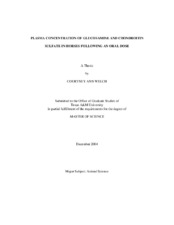| dc.description.abstract | This study was conducted to study absorption of glucosamine and chondroitin sulfate and to measure any changes in blood concentration of these compounds following feeding them to horses in different amounts. Six mature mares were used in a replicated 3x3 Latin square designed experiment. The experiment consisted of three 15-day periods, which included 10 days of diet adaptation followed by a 5-day sampling period. Blood was drawn on one day during each sampling period. Horses were fed a control diet (40% hay, 60% concentrate) balanced to meet NRC (1989) requirements for maintenance of mature horses. In one experimental diet, 2.0 g chondroitin sulfate and 5.5 g glucosamine were added to the basal ration at each feeding. In the other experimental diet, 3.5 g chondroitin sulfate and 8.5 g glucosamine were added to the basal ration at each feeding. Following total collections, blood was centrifuged and plasma was harvested and data analyzed for the presence of each compound. Analyses for plasma glucosamine were performed in the Protein and Chemistry Lab at Texas A&M University using HPLC. Chondroitin sulfate in the plasma was analyzed using a color reagent, dimethylmethylene blue, followed by UV spectrophotometry.
There were no significant differences (P<0.05) in the concentration of chondroitin sulfate or glucosamine concentrations in plasma when comparing the three different diets. This leads to a conclusion that these compounds were not absorbed through the intestinal wall into the bloodstream in the same form as they were fed. This poses a question as to whether or not oral forms of these compounds are absorbed and are able to migrate to joints through the blood to improve joint function. With the significant economic impact that products containing chondroitin sulfate and glucosamine are making in the animal nutrition industry, more research is needed to further elucidate actual efficacy of these compounds in diet supplements for horses. | en |


